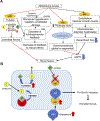Renal Injuries in Primary Aldosteronism: Quantitative Histopathological Analysis of 19 Patients With Primary Adosteronism
- PMID: 34120452
- PMCID: PMC8597934
- DOI: 10.1161/HYPERTENSIONAHA.121.17436
Renal Injuries in Primary Aldosteronism: Quantitative Histopathological Analysis of 19 Patients With Primary Adosteronism
Abstract
[Figure: see text].
Keywords: 11βHSD; aldosterone; histopathology; hypertension; mineralocorticoid receptor; renin.
Figures



References
-
- Rossi GP, Bernini G, Caliumi C, Desideri G, Fabris B, Ferri C, Ganzaroli C, Giacchetti G, Letizia C, Maccario M, Mallamaci F, Mannelli M, Mattarello MJ, Moretti A, Palumbo G, Parenti G, Porteri E, Semplicini A, Rizzoni D, Rossi E, Boscaro M, Pessina AC, Mantero F; for PAPY Study Investigators. A prospective study of the prevalence of primary aldosteronism in 1125 hypertensive patients. J Am Coll Cardiol. 2006;48(11):2293–2300. doi: 10.1016/j.jacc.2006.07.059. - DOI - PubMed
-
- Williams JS, Williams GH, Raji A, Jeunemaitre X, Brown NJ, Hopkins PN, Conlin PR. Prevalence of primary hyperaldosteronism in mild to moderate hypertension without hypokalemia. J Hum Hypertens. 2006; 20: 129–36. - PubMed
Publication types
MeSH terms
Grants and funding
LinkOut - more resources
Full Text Sources

